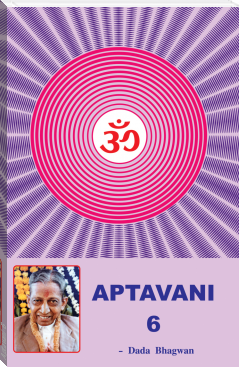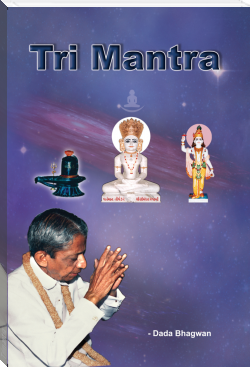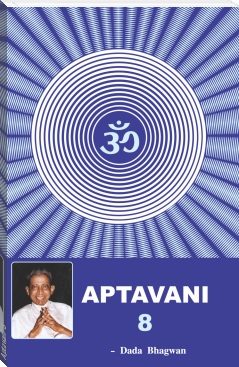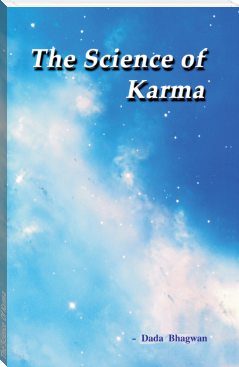Aptavani-6 by Dada Bhagwan (ebook reader web .txt) 📕

- Author: Dada Bhagwan
Book online «Aptavani-6 by Dada Bhagwan (ebook reader web .txt) 📕». Author Dada Bhagwan
Buddhi’s Ashaya and Bhaav (Inner Intent)
Questioner: So when he makes a decision about what he wants to enjoy, is it the buddhi’s ashaya (the receptacle of the intellect) that is at work?
Dadashri: Yes, it works according to buddhi’s ashaya. Whenever one makes an intent (bhaav) to enjoy something, he will have to enjoy it. Even if it is beyond his imagination, he will have to go through it, suffer or enjoy, providing he made the intent (bhaav) to do so. This is because in addition to buddhi’s ashaya, there is the support of his merit karma (punya).
So with the pratishtha of ‘I am this,’ and ‘this is mine,’ an entire body is created for one lifetime. Then, while doing the intent (bhaav), whatever was in his buddhi’s ashaya is exactly what gets ‘printed’ (gets recorded to give effect). Everyone has a receptacle of intellect ( buddhi’s ashaya).
Questioner: Is buddhi’s ashaya constantly changing?
Dadashri: Yes. As it changes, the imprints in the causal body are being recorded accordingly.
Questioner: What is the difference between intent (bhaav)and receptacle of intellect (buddhi’s ashaya)?
Dadashri: Bhaav is like seeing through colored glasses. Then despite having good eyes, whatever one sees through those eye glasses is what we call bhaav. Then he acts according to those bhaav—intents.It is on this that the entire worldly life arises.
Questioner: If what he sees through the ‘glasses’ is the intent (bhaav), then are the ‘eye-glasses’ (dravya karma ) an effect of previously caused karma?
Dadashri: Yes, the glass is dravya karma. That is what has entangled you. Everyone’s glasses are different. Everyone’s effect karma (dravya karma) is different. Dravya karma is discharge karma or ‘effect’ karma. Bhaav karma is charge karma or cause karma. People do not understand the difference between the two because they do not understand that the effect karma has the cause karma along with it. This is due to the ‘glasses’ that are instantly on when one says, ‘I am Chandulal.’ People consider that the effects in front of them are the results of the causes they see. Dravya karma (effect) people see; they believe it to be bhaav karma and the fruit of it they call dravya karma. When one becomes angry due to bhaav karma,they believe that to be dravya karma. But they only see with the ‘colored glasses.’
This matter of dravya karma is worth understanding. The matter of the receptacle of intellect is a separate issue.
Questioner: But what is the difference between buddhi’s ashaya (the receptacle of the intellect) and bhaav (inner intent)?
Dadashri: Everyone has bhaav karma but buddhi’s ashaya is different for everyone and it is dependent on location
(kshetra). What one sees through the glasses of, ‘I am Chandulal,’ is called the bhaav. Thereafter, the receptacle of the intellect is formed depending on the location and time (kshetra and kaad respectively). Buddhi’s ashaya is based on this bhaav.
But the glasses by themselves are not of much value. The way these glasses arise is based on whatever you do in this life. When you do things to make others happy, the glasses are clear and pure and thus you can see well. And if your actions cause unhappiness to others, the glasses will be dirty and you will not be able to see the right things, and so you will have to experience great misery. So it all depends on what one does according to these glasses. One has to use the same glasses his whole life.
What is the root of all this? The answer is that one already has the Gnan, the original knowledge within, but he has these ‘glasses’ over his Gnan and so he has to look through the glasses and do everything. This is like the blinders they put on bullocks. If there is a little gap in the blinders, then whatever the bullocks see through it causes them worries and suffering (upadhi) due to external causes. One receives everything according to his receptacle of intellect (ashaya). If one understands his ashaya, then it is more than enough. Do you understand this buddhi’s ashaya?
Questioner: Where one decides what kind of worldly interactions he wants, is there a receptacle of intellect (buddhi’s ashaya) in the decision he makes?
Dadashri: When one keeps looking for things that will give him pleasure, he starts believing that there is pleasure in those objects. Then he makes a bhaav – decides through intellect – that he can do without a bungalow and that he can get by with a small hut. So, in his next life he will get a hut to live in. Does everyone not have different homes that they like, and do they not sleep soundly in them?
Questioner: Yes, they do.
Dadashri: Do they fret all night long as to, ‘Why did he get that and I got this?’ No, they don’t. Why are they content with what they have? It is because their buddhi’s ashaya is, ‘I only feel comfortable in my home and in my own bed.’ Then it does not even matter if it is just a hut. You may comment on how his bed sags but he will tell you, ‘I can fall asleep only in this bed; I cannot sleep in a bungalow.’ If you were to feed gourmet meals every day to a person living in primitive areas, he will not be satisfied. He will feel trapped there and will run away after a few days.
Many people wear expensive clothes even when they cannot afford them, and many, despite being very rich, wear worn out clothes…that is buddhi’s ashaya.
A child will like only his father and mother even if they treat him badly. The father may not be on talking terms with his son all his life, but when he dies, he leaves everything to his son in his will. He leaves everything to his son even though his nephew took care of him all along. That is called buddhi’s ashaya.
Even Dada’s son and daughter died in their infancy. His buddhi’s ashaya was, ‘Why such hassle…why such bother?’ If a person has in hisashaya, ‘I will not work for anyone,’ he will not have to work under anyone. Therefore, everything happens according to buddhi’s ashaya.
Questioner: So whatever the worldly interaction, whatever the worldly evidence (nimit), living or non-living, whatever circumstances that come together, is the ashaya working behind all that?
Dadashri: Nothing comes together without buddhi’s ashaya.
Questioner: Now is buddhi’s ashaya the result of the activity of one’s chit (chintavan) from the past life? (Chit – the subtle component of vision and knowledge in the inner functioning instrument called
ImprintText: Dada Bhagwan Aradhana Trust
Images: Dada Bhagwan Aradhana Trust
Publication Date: 07-07-2017
All Rights Reserved





Comments (0)